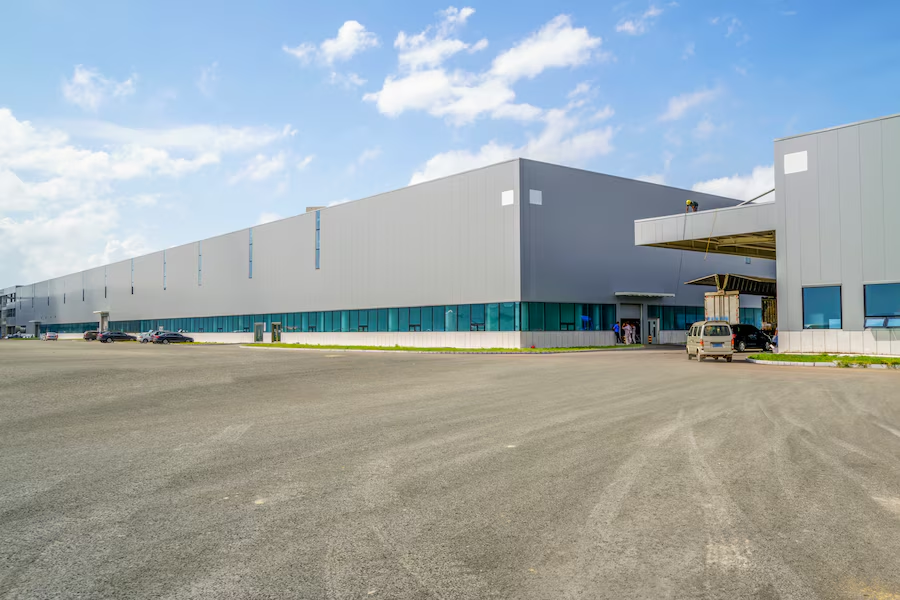
If your business owns and operates a warehouse, there are several things you can do from an architectural and design perspective to ensure optimum efficiency and safety. Understanding what these are, and how to execute on them, will yield the best results.
Here are some of the most important design strategies to keep in mind when optimizing your warehouse for both efficiency and safety.
1. Optimize Aisle Spacing
The layout of your aisles plays a huge role in warehouse efficiency. If aisles are too narrow, workers and forklifts may struggle to navigate safely, leading to slowdowns and potential accidents. If they’re too wide, you may be wasting valuable space that could be better utilized for storage.
To achieve the right balance, consider the types of equipment used in your warehouse. Standard forklifts require at least 12 to 13 feet of clearance, while narrow-aisle forklifts can operate in 8 to 10 feet of space.
Keeping pathways clear and dedicating specific areas for loading and unloading also ensures that workflow remains smooth and uninterrupted.
2. Implement Clear Signage
A well-organized warehouse relies on clear and consistent signage to minimize mistakes and prevent accidents. But not just any signs will do. They should be large, legible, and strategically placed to ensure that workers can quickly identify key areas (e.g. shipping zones, hazardous areas, storage sections, etc.).
For even better results, try color-coded labeling systems to help distinguish different sections of the warehouse. For example, red can be used for high-risk areas, green for safe zones, and yellow for cautionary locations. Colors can communicate information faster than words and symbols.
3. Optimize Workstations
Excessive movement is one of the biggest inefficiencies in warehouse operations. If employees have to walk long distances to retrieve tools, scan inventory, or complete tasks, it wastes time and energy. By strategically placing workstations near high-traffic areas, you can cut down on unnecessary movement and improve workflow.
Ergonomics should also be a top consideration. Workstations should be designed to minimize strain on workers, with adjustable surfaces, anti-fatigue mats, and accessible tools to reduce repetitive stress injuries. Keeping frequently used items within arm’s reach helps employees work faster and more comfortably.
4. Prioritize Proper Lighting
Good lighting is one of the most overlooked aspects of warehouse design, yet it has a direct impact on both safety and productivity.
Warehouses should have bright, evenly distributed lighting, especially in loading docks, picking areas, and high-traffic zones. LED lights are a great option because they provide high visibility while reducing energy costs. Additionally, installing motion-sensor lighting in less frequently used areas helps save on electricity while ensuring that workers always have proper illumination when needed.
5. Improve Ventilation
Warehouses can quickly become stuffy, overheated, and filled with dust or fumes, making proper ventilation a necessity. To improve air quality, design your warehouse with large exhaust fans, air filtration systems, and proper ventilation ducts.
If your warehouse handles chemicals or materials that produce fumes, local exhaust ventilation should be installed to remove contaminants from the air.
Temperature control is another key factor. Installing HVAC systems or large industrial fans helps regulate temperature, keeping employees comfortable and focused.
6. Create Designated Areas for Heavy Machinery Operation
Forklifts, pallet jacks, and conveyor belts are all essential elements for warehouse operations, but they can also be hazardous if not managed properly. To reduce the risk of accidents, warehouses should have dedicated zones for machinery operation, separate from pedestrian walkways. Here are a few suggestions:
- Install barriers, warning signs, and floor markings to help keep foot traffic away from active machinery, reducing the likelihood of collisions.
- In high-risk areas, consider using automatic sensors that trigger alarms or flashing lights when equipment is in use.
- Every warehouse should prioritize OSHA compliance, which includes ensuring that all workers operating heavy machinery are properly trained and forklift certified. Training programs should cover safe handling, emergency procedures, and equipment inspections to minimize risks.
7. Maximize Vertical Storage
When space is limited, the best way to expand storage capacity is by going up. Instead of cluttering your warehouse with floor-level racks and shelving, use vertical storage solutions to maximize available space.
Installing high-rise racking systems, mezzanines, and stackable shelving allows you to store more inventory without overcrowding your aisles. Automated storage and retrieval systems (AS/RS) can also be used to optimize space and speed up inventory management.
However, safety is crucial when utilizing vertical storage. Ensure that racks are properly secured and capable of handling weight loads, and train employees on safe lifting and retrieval practices to prevent injuries.
Adding it All Up
As you can see, there are plenty of proactive steps you can take to make your warehouse more efficient and safe. Sometimes, all it takes is a few tweaks to your warehouse’s design. If you’re willing to make these adjustments, it can impact everything from employee to safety to profitability.
